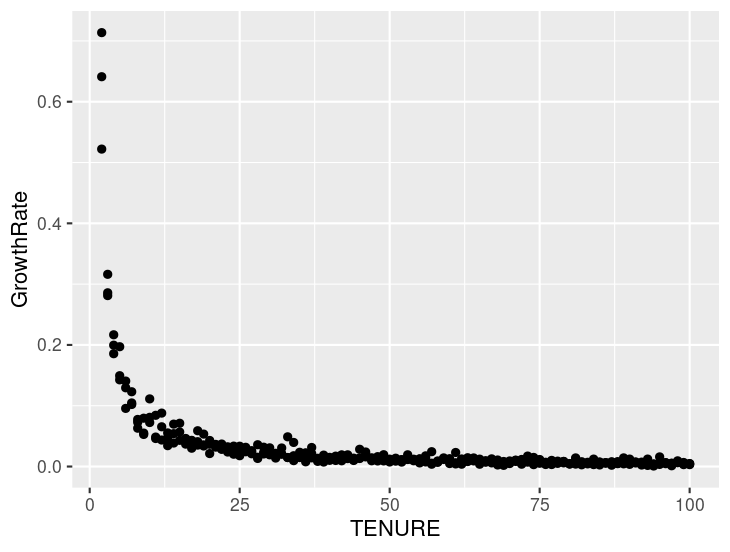An example data frame:
exdf <- structure(list(TENURE = c(2, 3, 4, 5, 6, 7, 8, 9, 10, 11, 12,
13, 14, 15, 16, 17, 18, 19, 20, 21, 22, 23, 24, 25, 26, 27, 28,
29, 30, 31, 32, 33, 34, 35, 36, 37, 38, 39, 40, 41, 42, 43, 44,
45, 46, 47, 48, 49, 50, 51, 52, 53, 54, 55, 56, 57, 58, 59, 60,
61, 62, 63, 64, 65, 66, 67, 68, 69, 70, 71, 72, 73, 74, 75, 76,
77, 78, 79, 80, 81, 82, 83, 84, 85, 86, 87, 88, 89, 90, 91, 92,
93, 94, 95, 96, 97, 98, 99, 100, 2, 3, 4, 5, 6, 7, 8, 9, 10,
11, 12, 13, 14, 15, 16, 17, 18, 19, 20, 21, 22, 23, 24, 25, 26,
27, 28, 29, 30, 31, 32, 33, 34, 35, 36, 37, 38, 39, 40, 41, 42,
43, 44, 45, 46, 47, 48, 49, 50, 51, 52, 53, 54, 55, 56, 57, 58,
59, 60, 61, 62, 63, 64, 65, 66, 67, 68, 69, 70, 71, 72, 73, 74,
75, 76, 77, 78, 79, 80, 81, 82, 83, 84, 85, 86, 87, 88, 89, 90,
91, 92, 93, 94, 95, 96, 97, 98, 99, 100, 2, 3, 4, 5, 6, 7, 8,
9, 10, 11, 12, 13, 14, 15, 16, 17, 18, 19, 20, 21, 22, 23, 24,
25, 26, 27, 28, 29, 30, 31, 32, 33, 34, 35, 36, 37, 38, 39, 40,
41, 42, 43, 44, 45, 46, 47, 48, 49, 50, 51, 52, 53, 54, 55, 56,
57, 58, 59, 60, 61, 62, 63, 64, 65, 66, 67, 68, 69, 70, 71, 72,
73, 74, 75, 76, 77, 78, 79, 80, 81, 82, 83, 84, 85, 86, 87, 88,
89, 90, 91, 92, 93, 94, 95, 96, 97, 98, 99, 100), GrowthRate = c(0.522068407541269,
0.285714748576455, 0.185508515947955, 0.197014234790025, 0.0955682840302288,
0.104550241818405, 0.0729165843177029, 0.052710172057008, 0.111205299930434,
0.0842167291103291, 0.0435357167369297, 0.0342561790820088, 0.0697015114811705,
0.0567551900498326, 0.0367956747574549, 0.0300708018467208, 0.0351762377682974,
0.0355785502062602, 0.0212760525934605, 0.0363614825795171, 0.0283660359906612,
0.0276822491674977, 0.0280297636181288, 0.0176973848620943, 0.0269962225046196,
0.0232995719858735, 0.0132348057981257, 0.0231117576016402, 0.0200135248674158,
0.0138992243554679, 0.0204646137008204, 0.0147834886226441, 0.0177097949074607,
0.014717031805624, 0.0132285475095113, 0.0212633514283631, 0.00842835296173483,
0.0145954105765114, 0.0101416096952409, 0.0134118780421613, 0.00938878674984167,
0.0129743252759109, 0.0109985830231452, 0.0283401588275556, 0.0204205991521889,
0.0093976137766294, 0.00910728837933128, 0.00916694752719849,
0.00741753979164272, 0.00881249103330362, 0.0111578966749217,
0.0192836374335688, 0.0120252563211682, 0.00586430387931181,
0.0143027002879901, 0.00370704967795099, 0.00682983045111385,
0.0141476105093492, 0.00482637041824496, 0.00420690319208639,
0.00376569470107668, 0.0109937747749598, 0.0140867803731126,
0.00371637851743323, 0.00717512598946612, 0.00768842197231479,
0.00251049125312619, 0.00187703000356798, 0.0048259385225542,
0.0100417595068638, 0.00374772165540982, 0.0171614859902469,
0.0149367579256126, 0.0115188216576438, 0.00490666943969309,
0.00530930735473234, 0.00723074299963677, 0.00592049387249816,
0.00484467566849744, 0.0124063039986577, 0.00573257723329412,
0.00427949785279758, 0.0030963281113916, 0.00252914919374447,
0.00635090782429515, 0.00210452127168104, 0.00804075169058649,
0.00436670408574535, 0.0035060879778257, 0.00713604840396798,
0.0023981009089411, 0.00175704532860088, 0.000779919174233257,
0.00340671636283396, 0.00460636923636137, 0.00120733393667471,
0.00933279440430645, 0.00305741675516025, 0.00304857402624847,
0.641110630691566, 0.281083708481502, 0.21664831342118, 0.142526508746734,
0.129455004633227, 0.102003156382356, 0.0774235271374781, 0.0549670789691081,
0.0809027507369802, 0.0460263351173751, 0.0653262071979981, 0.047154349769059,
0.0385947285426713, 0.0430288757773969, 0.0406360525819185, 0.0430116335897406,
0.0588492430703393, 0.0532880434533727, 0.0428311618518791, 0.0318427099482772,
0.028791324553973, 0.023804027169529, 0.0201765096165349, 0.0333877840776626,
0.02423781438746, 0.0209281238862644, 0.0152334901166924, 0.0206101546399822,
0.0192309106927642, 0.0217159111858543, 0.0204661728941318, 0.0147045919062503,
0.00963324607321603, 0.0168095825286532, 0.00772585884807775,
0.0141943686223769, 0.0105122199425551, 0.00730692991230875,
0.01505280063156, 0.00993250009012492, 0.0190685740493759, 0.0138696114197483,
0.00991543096798608, 0.0140457461257082, 0.0238644668564838,
0.014335212464454, 0.016231440976755, 0.0136006335528513, 0.010508195169141,
0.0108223681012323, 0.00724634873393271, 0.0114878660557896,
0.010768179227167, 0.0125569796266074, 0.00746257416521345, 0.00541761544241481,
0.00915133561343495, 0.0128090265857459, 0.0128834975364693,
0.00616011529066718, 0.0124072342143222, 0.00813729534453778,
0.00918992619169501, 0.00776227156683262, 0.00770248250797501,
0.00588355687767006, 0.00690140085420765, 0.00508911144051716,
0.00911620445070582, 0.00830466702459098, 0.00520036975577831,
0.00716886970824682, 0.00303064818576892, 0.0053193981576598,
0.00327658374593653, 0.00321651271471524, 0.00513516303969652,
0.00823984725674798, 0.00417642468764257, 0.014131171763804,
0.00787422067561749, 0.00692890013640657, 0.0121753072926065,
0.0070034266847312, 0.00540091988640867, 0.00689103254072876,
0.00506455733404643, 0.00598304422775975, 0.00661625550389644,
0.00732959383078224, 0.00720982160244255, 0.00564679063948148,
0.00435863414775284, 0.00556842035294203, 0.00603506069392346,
0.00548744139395829, 0.00660639356662429, 0.0045943028618467,
0.00490921014265311, 0.713632131494036, 0.316109107238324, 0.19955189191854,
0.149362726365638, 0.140527584352695, 0.122967115856381, 0.0629710542708235,
0.0794423836726601, 0.0723283480042465, 0.048411305500041, 0.0878323397155594,
0.0552740672330323, 0.0540408087274855, 0.0711265884999275, 0.0461176344041601,
0.0421688829740532, 0.0408229960327535, 0.0337191263188075, 0.0365627089380531,
0.0343486264915729, 0.0369672518324808, 0.0324027127903612, 0.0335280505737625,
0.0241231062680551, 0.0315868501489174, 0.0260876281368159, 0.0358190565406051,
0.031770274327048, 0.0307189115217597, 0.0204031908865456, 0.0304622366438121,
0.0488170927658, 0.0395661396435187, 0.0234030909209384, 0.0225458543480528,
0.0312754025113176, 0.0135110740643416, 0.0187184090181205, 0.013568316123143,
0.0170345821576348, 0.0184100113763801, 0.019219623166352, 0.0137349197436514,
0.0131633552715194, 0.0157758351970561, 0.0117732814253362, 0.0111181879788198,
0.0193989282426799, 0.0121149862839278, 0.0136437991248339, 0.0111608014682734,
0.011828405955594, 0.00944009280512503, 0.0123120446979428, 0.0175349768061963,
0.0243703580512893, 0.00775361404112473, 0.0115755699642719,
0.00869789602322868, 0.0230748185953917, 0.011388761136665, 0.0144514590777103,
0.0114791528596783, 0.0121005997846328, 0.00959154057558642,
0.0125793490404558, 0.0106768149670486, 0.00824512497201191,
0.0076573705531775, 0.0104520640098951, 0.0115961878675463, 0.0132315972263175,
0.00453620536761079, 0.00996315028677053, 0.00699906839894915,
0.0100602309904119, 0.00881275005589721, 0.00840590467502622,
0.00410243169790725, 0.00393864651260856, 0.0027632056756115,
0.00604623344076316, 0.00644190206596029, 0.0073296018951492,
0.0062144137386646, 0.00779570731803325, 0.00465780201362875,
0.0141815826452891, 0.0121929551749531, 0.00573235434597308,
0.00512844095153575, 0.0122186637666211, 0.00354975243105926,
0.0158151971904505, 0.006405119131486, 0.00504244314036839, 0.00623419419033411,
0.00664127009174464, 0.00428700468190435)), row.names = c(NA,
-297L), class = c("tbl_df", "tbl", "data.frame"))
Here's a plot of the data:
exdf |>
ggplot(aes(x = TENURE, y = GrowthRate)) +
geom_point()
I would like to model GrowthRate as a function of Tenure.
Just eyeballing the plot, I thought that maybe a Weibull regression would be appropriate. However, all I could find there was survival analysis where one passes a Surv() object to a regression and where the surv object contains 1/0 data for whether or not the observation has survived or not. i.e. binary data.
I'm being deliberately open ended here. What is a 'good' way to model the relationship between GrowthRate and Tenure (in R)?



lm(GrowthRate^(1/3) ~ I(-TENURE^(-1/3)), exdf)and you can go on from there. But parts of your post remain mysterious. I don't understand why you insist on some form of "Weibull regression," whatever that might mean. And what does this have to do with survival analysis? There's no indication of right censoring. $\endgroup$